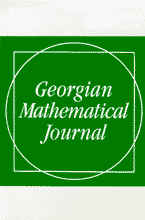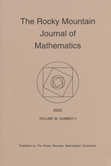
Azerbaijan Journal of Mathematics
Scope & Guideline
Elevating Mathematics: Where Research Meets Global Impact
Introduction
Aims and Scopes
- Functional Analysis and Operator Theory:
The journal extensively publishes research related to functional analysis, including the study of operators in various function spaces, which is crucial for understanding mathematical structures and their applications. - Differential Equations and Boundary Value Problems:
A significant portion of the publications addresses differential equations, particularly those related to boundary value problems, reflecting the journal's commitment to advancing knowledge in this fundamental area of mathematics. - Approximation Theory and Inequalities:
The journal showcases studies on approximation methods and inequalities, highlighting its role in providing tools for solving complex mathematical problems across different disciplines. - Matrix Theory and Linear Algebra:
Research on matrix theory, including properties and applications of matrices in various mathematical contexts, is a consistent theme, showcasing the journal's focus on linear algebra. - Mathematical Modeling and Applications:
The journal includes papers on mathematical modeling, indicating its relevance to real-world applications, particularly in areas intersecting with physics, biology, and engineering.
Trending and Emerging
- Fuzzy Logic and Its Applications:
Recent publications have increasingly focused on fuzzy logic, showcasing its growing importance in modeling uncertainty and vagueness in various mathematical contexts. - Fractional Differential Equations:
There is a rising trend in research on fractional differential equations, indicating a growing interest in non-integer order derivatives and their applications in modeling complex systems. - Nonlocal Boundary Value Problems:
The exploration of nonlocal boundary value problems is gaining traction, reflecting a broader interest in problems that do not adhere to traditional local conditions and their implications in various mathematical fields. - Sobolev Spaces and Their Generalizations:
Research on Sobolev spaces, particularly with variable exponents or new generalizations, is emerging, indicating a trend towards exploring more refined function spaces for analysis. - Operator Theory in Nonlinear Contexts:
An increase in studies focusing on nonlinear operator theory highlights the journal's responsiveness to contemporary challenges in mathematical analysis, particularly in understanding complex systems.
Declining or Waning
- Classical Analysis:
There has been a noticeable decrease in publications related to classical analysis, which traditionally focused on foundational aspects of calculus and real analysis, suggesting a shift towards more applied or modern mathematical approaches. - Statistical Methods and Probability Theory:
Research centered on statistical methods and probability theory appears to be less prominent in recent issues, possibly reflecting a trend towards more deterministic mathematical models over probabilistic approaches. - Pure Mathematics without Applications:
Papers that delve purely into abstract mathematics without clear applications seem to be waning, indicating a preference for research that connects more directly to applied mathematics or interdisciplinary studies.
Similar Journals

Georgian Mathematical Journal
Exploring the depths of mathematics for global impact.Georgian Mathematical Journal, published by Walter de Gruyter GmbH, is a prestigious academic journal dedicated to the field of mathematics, particularly in its multifaceted applications and theoretical explorations. With an ISSN of 1072-947X and an E-ISSN of 1572-9176, this journal is indexed within notable databases and holds a strong position as evidenced by its Q2 ranking in the Mathematics (miscellaneous) category as of 2023 and a ranking of #140 out of 399 in the general mathematics Scopus category, placing it in the 65th percentile for research visibility. Since its inception in 1994, the journal has continued to evolve, aiming to foster innovative research and scholarly communication among mathematicians worldwide. Although it does not offer Open Access, the journal’s commitment to quality and rigor ensures that published works are of high relevance, appealing to researchers, educators, and students who are dedicated to advancing mathematical knowledge across diverse domains.

ROCKY MOUNTAIN JOURNAL OF MATHEMATICS
Exploring the Depths of Mathematical InnovationROCKY MOUNTAIN JOURNAL OF MATHEMATICS, published by the Rocky Mountain Math Consortium, serves as a critical platform for researchers and practitioners in the field of mathematics since its inception in 1971. With a notable presence in the academic community, this journal covers a broad spectrum of mathematical disciplines, positioning itself in the Q2 category for Mathematics (miscellaneous) as of 2023. Despite being a subscription-based journal, it is recognized for its rigorous peer-review process and contributions to theoretical and applied mathematics, helping to advance knowledge and foster collaboration among mathematicians. The journal's ISSN number is 0035-7596 and its E-ISSN is 1945-3795, reflecting its commitment to accessibility and dissemination of high-quality research. Based in Tempe, Arizona, at Arizona State University, the journal continues to play an important role in shaping contemporary mathematical discourse through well-researched articles and innovative studies, aiming to bridge gaps between various mathematical subfields and engage a diverse audience, including students and established researchers alike.

Rendiconti del Circolo Matematico di Palermo
Fostering Scholarly Dialogue Across Mathematical Disciplines.Rendiconti del Circolo Matematico di Palermo, published by SPRINGER-VERLAG ITALIA SRL, is a revered journal in the field of mathematics, emphasizing the cultivation and dissemination of mathematical knowledge since its inception in 1887. With its ISSN 0009-725X and E-ISSN 1973-4409, this esteemed publication has continued to thrive, showcasing innovative research, comprehensive reviews, and thoughtful discussions from diverse areas in mathematics, particularly in its Q2 ranking within the miscellaneous mathematics category. Its historical significance is underscored by its convergence of publications across numerous years, including its notable periods from 1887 to 1916, 1919 to 1938, and beyond, effectively capturing the evolution of mathematical thought. Though not open access, the journal remains an essential resource for researchers, professionals, and students aiming to stay updated with the latest advancements and methodologies in the ever-evolving landscape of mathematics. With its Scopus rank placing it in the top 25th percentile, Rendiconti del Circolo Matematico di Palermo continues to be a cornerstone for scholarly dialogue and development in its domain.

Publications de l Institut Mathematique-Beograd
Connecting researchers with groundbreaking mathematical ideas.Publications de l Institut Mathematique-Beograd is a distinguished journal in the field of mathematics, published by Publications L Institut Mathematique Matematicki in Serbia. With an ISSN of 0350-1302, it aims to disseminate high-quality research across various domains of mathematics, fostering academic discourse and innovation. Despite its open access status being unspecified, the journal is accessible to a wide audience, supporting an inclusive environment for knowledge sharing. The journal's impact is reflected in its 2023 category quartile ranking of Q3 in Mathematics (Miscellaneous), verifying its contribution to the mathematical community. With a Scopus ranking placing it in the 22nd percentile of general mathematics, it serves as a vital resource for researchers, professionals, and students eager to stay abreast of contemporary mathematical advancements. Since its convergence in 2002, and with ongoing publications continuing through 2024, this journal remains a crucial platform for sharing innovative mathematical ideas and results.

Carpathian Mathematical Publications
Showcasing Cutting-Edge Research from the Carpathians.Carpathian Mathematical Publications, published by Vasyl Stefanyk Precarpathian National University, stands as a significant contribution to the field of mathematics, particularly highlighted by its Q2 ranking in Mathematics (miscellaneous) for 2023. With an ISSN of 2075-9827 and E-ISSN of 2313-0210, this Open Access journal, initiated in 2009, enables researchers and practitioners worldwide to freely access cutting-edge mathematical research, thus promoting knowledge sharing and collaboration. Based in Ivano-Frankivsk, Ukraine, the journal focuses on a broad spectrum of mathematical topics while fostering innovative approaches and interdisciplinary connections within the mathematical community. Its current Scopus ranking of rank #122 out of 399 reflects its growing influence and importance, making it an ideal platform for scholars and students aiming to advance their research and stay abreast of the latest developments in general mathematics.

St Petersburg Mathematical Journal
Exploring the Depths of Algebra and Number TheorySt Petersburg Mathematical Journal, published by the American Mathematical Society, is a distinguished platform that fosters research and discourse in the fields of mathematics, specifically focusing on Algebra and Number Theory, Analysis, and Applied Mathematics. With an ISSN of 1061-0022 and an E-ISSN of 1547-7371, this journal has been a reliable source of cutting-edge mathematical research since its inception in 2003 and continues to publish high-quality content through 2024. Although not open-access, it offers valuable insights and advances the mathematical community's understanding, as indicated by its respectable impact factor and Scopus rankings across various categories—landing in the Q3 quartile across three significant mathematical disciplines. Researchers, professionals, and students are encouraged to contribute and engage with this journal, as it remains a vital resource for promoting collaboration and discovery within the ever-evolving field of mathematics.

Revista Matematica Complutense
Championing High-Impact Research in MathematicsRevista Matematica Complutense is a prestigious peer-reviewed journal published by SPRINGER-VERLAG ITALIA SRL, specializing in the field of mathematics. With its ISSN 1139-1138 and E-ISSN 1988-2807, the journal plays a vital role in disseminating high-quality research and fostering academic discussion within the mathematics community. Recognized for its rigorous selection process, the journal has achieved impressive rankings, holding a Q1 quartile status in the miscellaneous mathematics category as of 2023 and ranking #94 out of 399 in general mathematics according to Scopus, placing it within the 76th percentile. With a publication timeline spanning from 2008 to 2024, the Revista Matematica Complutense continues to serve as an essential resource for researchers, professionals, and students alike. Although it does not currently offer open access, the journal remains committed to advancing mathematical knowledge and providing a platform for innovative research across various mathematical disciplines.

CUBO-A Mathematical Journal
Connecting Researchers in the World of MathematicsCUBO-A Mathematical Journal, published by the Department of Mathematics and Statistics at Universidad de La Frontera in Chile, stands as a significant Open Access resource in the field of mathematics since its inception in 2011. With an ISSN of 0716-7776 and an E-ISSN of 0719-0646, this journal invites submissions that explore a wide spectrum of mathematical disciplines, including Algebra, Number Theory, Analysis, Geometry, Topology, and Logic. Although currently positioned in the Q4 category across various mathematical domains and registered at Rank #223/399 in General Mathematics in Scopus, CUBO serves as a valuable platform for emerging researchers and practitioners to disseminate their findings. Operating under a continuous commitment to accessibility, CUBO fosters an inclusive academic environment that supports the exchange of innovative ideas vital to advancing mathematics. The journal's target audience encompasses a diverse community of researchers, professionals, and students eager to participate in the expanding dialogue within mathematical sciences.

ACTA SCIENTIARUM MATHEMATICARUM
Elevating Understanding through Rigorous ResearchACTA SCIENTIARUM MATHEMATICARUM, published by SPRINGER BIRKHAUSER in Switzerland, is a distinguished journal focusing on the fields of mathematical analysis and applied mathematics. With an ISSN of 0001-6969 and an E-ISSN of 2064-8316, this journal serves as a critical platform for disseminating high-quality research that bridges theoretical and practical aspects of mathematics. Although currently categorized in the Q3 quartile for both Analysis and Applied Mathematics as of 2023, the journal strives to enhance its impact on the mathematical community by offering a perfect blend of rigorous research and innovative applications. Researchers, professionals, and students can benefit from the journal’s commitment to advancing knowledge in mathematics, despite the absence of open-access options. The mailing address for correspondences is 233 SPRING STREET, 6TH FLOOR, NEW YORK, NY 10013. As mathematics continues to evolve, ACTA SCIENTIARUM MATHEMATICARUM positions itself as a valuable resource for those looking to contribute to and stay informed about the latest developments in this vibrant field.

Thai Journal of Mathematics
Fostering knowledge exchange to shape the future of mathematics.Thai Journal of Mathematics (ISSN: 1686-0209) is a distinguished publication within the mathematical sciences, based at Chiang Mai University, Faculty of Science in Thailand. With a focus on diverse mathematical topics, the journal has been actively publishing since 2011 and aims to present original research, reviews, and innovative applications that contribute to the global mathematical community. Despite its current Q4 ranking in Mathematics (miscellaneous) and a modest percentile in Scopus Ranks, it serves as a vital platform for researchers and educators looking to disseminate their findings and engage with emerging trends in mathematics. The journal supports open sharing of knowledge, fostering collaborations and discussions across borders, which is essential for the advancement of mathematical education and research. Researchers, professionals, and students are encouraged to contribute and access valuable insights that shape the future of mathematics.